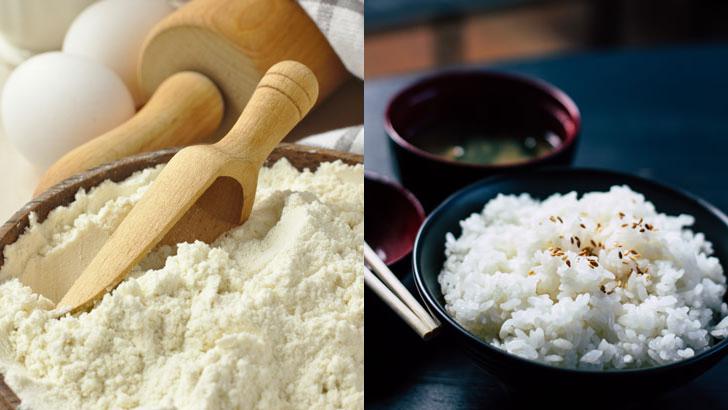Millet flour vs White rice: How Do They Compare?

Millet flour and white rice belong to the grains food group, one of the staple food groups for people on a plant-based diet.
Grains and grain products are an affordable source of carbohydrates, as well as essential vitamins and minerals, including B vitamins (such as thiamin, riboflavin, and niacin), iron, and zinc, minerals that are usually harder to get on a plant-based diet.
They also provide a small amount of protein and healthy fats.
However, it is important to note that whole grains are generally a better source of these nutrients than refined grains.
This article will thoroughly compare millet flour and white rice and help you learn more about their similarities and differences.
Millet flour
Millet flour (Panicum miliaceum) is made from ground millet, which is an ancient grain that is grown in many parts of the world, including Africa, Asia, and Europe.
It is a good source of carbohydrates, dietary fibers, and small amounts of vitamins and minerals like magnesium, phosphorus, and B vitamins. It is also gluten-free and easy to digest, making it a great option for people with gluten sensitivities or celiac disease.
Millet flour is commonly used in baking and is a good alternative to wheat flour for gluten-free or alternative baking. It is also used in traditional African and Asian dishes.
Millet flour is considered a functional food, as it has been shown to positively impact health when consumed regularly as part of a balanced diet. It is also a sustainable crop, as it is drought-tolerant and can be grown in poor soil conditions.
Millet flour is an excellent source of Vitamin B1 (Thiamine), Vitamin B3 (Niacin), and Vitamin B5 (Pantothenic acid).
It also contains a good amount of Vitamin B6 (Pyroxidine), and Vitamin B9 (Folate) and some Vitamin B2 (Riboflavin).
White rice
White rice (Oryza sativa) has had its husk, bran, and germ removed, leaving only the starchy endosperm. This process, called milling, makes the rice less nutritious but increases its shelf life and gives it a lighter color and texture.
White rice is a good source of carbohydrates, small amounts of protein, and fiber. It is gluten-free and easy to digest, making it a great option for people with gluten sensitivities or celiac disease.
White rice is a staple food in many cultures and is often used as a side dish, in soups and stews, and as an ingredient in salads and sushi. It is also considered a functional food, as it has been shown to positively impact health when consumed regularly as part of a balanced diet.
White rice is a gluten-free alternative to wheat-based products, making it a good option for people with gluten sensitivities or celiac disease. However, brown rice and other types of whole grains are less nutritious than brown rice, as it has had its bran and germ removed.
White rice is an excellent source of Vitamin B5 (Pantothenic acid).
It also contains a good amount of Vitamin B3 (Niacin) and some Vitamin B1 (Thiamine), Vitamin B2 (Riboflavin), and Vitamin B6 (Pyroxidine).
Millet flour vs White rice Nutrition
Now that we’ve described the origin, taste, and usage of these foods, we can move to the most interesting part – comparing millet flour vs white rice.
This comparison will start by comparing the caloric value of millet flour and white rice and their macronutrients and then go more in-depth by analyzing their vitamin and mineral content.
| Millet flour | White rice | |
|---|---|---|
| Energy | 382 kcal | 360 kcal |
| Carbs | 75.1 g | 79.3 g |
| Sugar | 1.66 g | 1.88 g |
| Fiber | 3.5 g | 3.3 g |
| Protein | 10.8 g | 6.61 g |
| Fat | 4.25 g | 0.58 g |
| Saturated Fat | 0.536 g | 0.158 g |
Millet flour vs White rice Calories
Most calories in grains come from carbs.
Comparing white rice vs millet flour for weight loss, white rice is slightly lower in calories, with 360 calories per 100 grams, compared to 382 calories per 100 grams of millet flour.
However, both millet flour and white rice can and should be a part of a healthy diet, and neither one shouldn’t be avoided if you’re looking to lose weight.
Millet flour vs White rice Protein
Grains and most grain products, including millet flour and white rice, are important sources of plant-based protein.
However, it should be noted that most grains, with the exception of quinoa and buckwheat, for example, are low in lysine and methionine.
That said, you can combine grains with legumes to get a complete protein.
Millet flour offers around 39% more protein than white rice.
Millet flour has 10.8 grams of protein per 100 grams, while white rice has 6.6 grams of protein per 100 grams.
Millet flour vs White rice Carbs
Counting carbs can be important for some people for different reasons, including blood sugar control, weight management, or athletic performance.
It’s also important for people on a keto diet, so let’s compare the carbs content in millet flour and white rice.
The total amount of carbohydrates is around 5% higher in white rice than in millet flour. It has 79.3 grams per 100 grams, compared to 75.1 grams in millet flour.
There’s less sugar in millet flour than in white rice, 11% precisely.
That said, 100 grams of millet flour contains 1.7 grams of sugar, while the same amount of white rice contains 1.9 grams.
Lastly, let’s take a look at the dietary fiber in millet flour and white rice.
Dietary fiber keeps the digestive system healthy and helps with weight management by promoting a sense of fullness.
With 3.5 grams of fiber per 100 grams, millet flour is a better source of fiber than white rice which millet flour offers 3.3 grams per 100 gram portion.
Millet flour vs White rice Fats
Like most other grains, millet flour and white rice are low in fat.
Fats in millet flour and white rice are mostly healthy unsaturated fats. They are naturally cholesterol-free and trans-fat-free.
Total fat in millet flour and white rice:
- Millet flour: 4.3 grams per 100 grams
- White rice: 0.6 per 100 grams
Speaking of saturated fats, white rice is 60% lower in saturated fats.
White rice and millet flour contain 0.2 grams and 0.5 grams of saturated fat per 100 grams, respectively.
Millet flour vs White rice Vitamins Content
This section will discuss the vitamin content of millet flour and white rice.
Vitamins are micronutrients, meaning we need only a small amount. However, they are very important for many processes in our bodies.
Millet flour has a higher amount of vitamin A, vitamin B5 (Pantothenic acid), and vitamin E.
However, white rice has a higher amount of vitamin B1 (Thiamine), vitamin B2 (Riboflavin), vitamin B3 (Niacin), vitamin B6 (Pyroxidine), vitamin B9 (Folate), and vitamin K.
Millet flour and white rice contain the same amount of vitamin C, vitamin D, and vitamin B12 (Cobalamin).
The following table shows the exact amount of vitamins millet flour and white rice contain side by side, so you can easily compare them.
| Millet flour | White rice | |
|---|---|---|
| Vitamin A | 9 IU | 62 IU |
| Vitamin C | 0 | 0 |
| Vitamin D | 0 | 0 |
| Vitamin B1 (Thiamine) | 0.413 mg | 0.07 mg |
| Vitamin B2 (Riboflavin) | 0.073 mg | 0.048 mg |
| Vitamin B3 (Niacin) | 6.02 mg | 1.6 mg |
| Vitamin B5 (Pantothenic acid) | 1.27 mg | 1.34 mg |
| Vitamin B6 (Pyroxidine) | 0.372 mg | 0.145 mg |
| Vitamin B9 (Folate) | 42 µg | 9 µg |
| Vitamin B12 (Cobalamin) | 0 | 0 |
| Vitamin E | 0.11 mg | 0.37 mg |
| Vitamin K | 0.8 µg | 0.5 µg |
Millet flour vs White rice Minerals Content
Minerals are important for our body to function properly. We need only a small amount of minerals, so they are called micronutrients.
Some minerals, like iron, calcium, zinc, or iodine, are relatively hard to get on a plant-based diet, so it’s important to choose your foods thoughtfully. This part of the millet flour and white rice comparison focuses on their mineral content.
Millet flour is a better source of manganese, and selenium than white rice.
On the other hand, white rice is a higher amount of calcium, copper, iron, magnesium, phosphorus, potassium, sodium, and zinc.
Millet flour and white rice contain the same amount of fluoride.
Check out the table below to learn how millet flour and white rice compare when it comes to mineral content.
| Millet flour | White rice | |
|---|---|---|
| Calcium | 14 mg | 9 mg |
| Copper | 0.535 mg | 0.11 mg |
| Fluoride | 0 | 0 |
| Iron | 3.94 mg | 0.8 mg |
| Magnesium | 119 mg | 35 mg |
| Manganese | 1 mg | 1.1 mg |
| Phosphorus | 285 mg | 108 mg |
| Potassium | 224 mg | 86 mg |
| Selenium | 32.7 µg | 78.8 µg |
| Sodium | 4 mg | 1 mg |
| Zinc | 2.63 mg | 1.16 mg |
The Final Word
This article highlighted the similarities and differences between millet flour and white rice.
Grains, also known as cereal grains, are an important source of nutrition for many people around the world. They are a rich source of carbohydrates, which provide energy for the body.
Whole grains contain important vitamins and minerals, such as B vitamins and iron. Whole grains, in particular, are high in dietary fiber and can help with digestion and weight management.
They may also have other health benefits, such as reducing the risk of heart disease, diabetes, and certain types of cancer.
Grains are also a staple food and an important source of food security in many parts of the world.
Holy Peas has strict sourcing guidelines and draws only from high-quality sources, including peer-reviewed studies, academic research institutions, and medical journals, associations and government institutions. Read more about our process.
- Millet flour Nutrients, U.S. Department of Agriculture, Agricultural Research Service https://fdc.nal.usda.gov/fdc-app.html#/food-details/167746/nutrients
-
White rice Nutrients, U.S. Department of Agriculture, Agricultural Research Service https://fdc.nal.usda.gov/fdc-app.html#/food-details/167746/nutrients
-
Listing of vitamins, Harvard Health Publishing, Harvard Medical School https://www.health.harvard.edu/staying-healthy/listing_of_vitamins/
-
Appendix 7. Nutritional goals for age-sex groups based on dietary reference intakes and Dietary Guidelines recommendations. (n.d.).
https://health.gov/dietaryguidelines/2015/guidelines/appendix-7/
-
International tables of glycemic index and glycemic load values 2021: a systematic review
https://academic.oup.com/ajcn/article/114/5/1625/6320814?login=false
-
Health Claim Notification for Saturated Fat, Cholesterol, and Trans Fat, and Reduced Risk of Heart Disease
https://www.fda.gov/food/food-labeling-nutrition/health-claim-notification-saturated-fat-cholesterol-and-trans-fat-and-reduced-risk-heart-disease
-
Nutrient Recommendations: Dietary Reference Intakes (DRI), Food and Nutrition Board of the National Academies of Sciences Engineering, and Medicine
https://ods.od.nih.gov/HealthInformation/nutrientrecommendations.aspx
-
Protein And Amino Acid Requirements In Human Nutrition, WHO
https://apps.who.int/iris/bitstream/handle/10665/43411/WHO_TRS_935_eng.pdf
-
Nutrition Facts Labeling RDIs Nutrients, U.S. Food and Drug Administration
https://www.fda.gov/media/99069/download
-
Nutrition Facts Labeling DRVs Food Components, U.S. Food and Drug Administration
https://www.fda.gov/media/99059/download
- It's written and or reviewed by an expert.
- We cite relevant studies and trusted sources.
- It's regularly updated.
Read more about our process and team.






